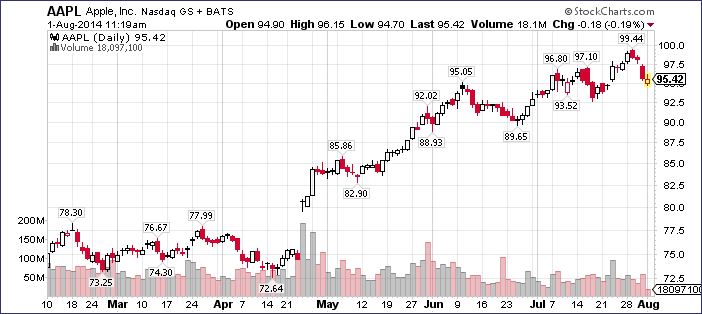What is Max Pain? Why do stock prices tend to gravitate toward big round numbers (pin) on option expiration?
What is Max Pain Theory? (from max-pain.com)
Max pain theory says that the option writers will hedge the contracts they have written. In the case of the market maker, the hedging is done to remain neutral in the stock. Consider the market makers position if he must write an option contract without wanting a position in the stock. As the maturity date approaches, the stock price changes. In addition, contracts may be closed by the option buyers. As a result the option writer must re-balance his hedges. This re-balancing is an effort to hedge the open contracts, thus maintaining a state where the least amount of money will be paid out. Re-balancing of positions in the stock provide pressure on the price to close at the max pain point.
It goes along with the option expiration PIN/PEG.
The PEG/PIN is when a stock closes on options expiration right at a specific strike price. For option sellers, this is wonderful. For option buyers..... not so much. I have written about this previously:
PEGGED – AAPL and GOOG Stock Prices Manipulated On Options Expiriation (PART I)
If you think the price of a stock intra-day is based solely on investors opinion of a stock, it is not.
For instance. This week the max pain for $AAPL is $111. If $AAPL closes at $111 at the end of this week, if will inflict the most pain upon the buyers of options, and be most beneficial to those who sold options. All the money spent on out of the money options goes right into the pocket of the option writers.
$GOOGL's max pain this week is $800

Max pain is another tool in an option traders tool belt. And can give a good indication of where the price may head as the week progresses.
Lets put it to test this week with a few max pain targets for the week.
We already have $AAPL $111 and $GOOGL $800 Max Pain figures. Let's add a few more and see just how well the max pain theory works this week.
$SPY - $217 TWTR - $18.5 $FB - $129 $HD - $129 $QQQ -$118 $AAPL - $111 $GOOGL - $800
more on max pain theory (source Yahoofinance) :
As options have become more popular trading instruments for retail investors, new stock trading strategies revolving around option expiration dates have taken hold in the market.
While many retail traders buy and sell options, option writers themselves have a lot to gain from the contracts expiring worthless. Call writers want share prices to fall below the strike price of their contracts, and put writers want prices to rise above the strike price of their contracts.
However, there is one price at which both calls and puts expire worthless: the strike price itself. If a stock closes at a nice round number, such as $100, on an expiration date, all the call options and put options with $100 strike prices that expire on that date will expire worthless.
Option buyers lose, and option writers win.
Of course, there are a wide range of strike prices for any given expiration date, but usually there are one or two strike prices that have an exceptional number of option contracts written for them.
Since the strike price with the most open contracts is the price at which the stock would cause option holders the largest financial losses, this price is referred to as the "max pain" price.
Maximum Pain
The idea behind the "Maximum Pain Theory" is this: As option expiration approaches, option writers will try to buy or sell shares of stock to drive the price toward a closing price that is profitable for them, or at least to hedge their payouts to the option holders.
Call writers sell shares to drive share price down and put writers buy shares to drive share price up, and at the center of the chaos is the max pain strike price itself.
Essentially, all of this buying and selling "funnels" the share price toward the max pain strike price on expiration dates. For example, Tesla Motors Inc (NASDAQ: TSLA) closed on November 5 at $230.97. As of November 6, the graph of the total cash value for each Tesla weekly (November 7 expiration) option strike price looked like this:

The graph shows different strike prices on the x-axis and total cash value that would be paid out on all calls and puts at each strike price on the y-axis. Since a strike price of $235.00 has the lowest cash value of any of the strike prices, $235 is Tesla’s max pain price for November 7 expiration.
Of course, option trading occurs every single day, and the max pain price can change on an hour-by-hour basis. Since Tesla was trading above $244 on the morning of November 6, Max Pain Theory suggests that it might be a good time for traders to take profits before weekly expiration.
In theory, call writers and put writers will be “pushing” Tesla’s share price in the direction of $235 before November 7, and that direction would be down.
Does Maximum Pain Theory Work?
There is little evidence that Max Pain Theory, or "pinning," is a short-term trading strategy that can be relied on consistently. However, it does seem as though certain round numbers have a magnet-like pull on share price during the final hour of trading on Friday afternoon.
The stock market is not a laboratory.
There are no laws that dictate stock price movement, only ideas that do so. If enough traders believe an idea is true, it doesn’t have to actually be true to be a viable trading strategy. If traders believe an idea is true, the resulting price movement will be the same as if the idea were actually true.
A Self-Fulfilling Prophecy?
The only real thing that moves share price is buyers and sellers. While it's nice to see a stock rise because of something good that a company is doing, the money is just as green if the share price rises because other traders are misinformed.
In that sense, Max Pain Theory is possibly an example of a self-fulfilling prophecy. It doesn't matter if the theory actually works, if traders believe it works, they will buy and sell as if it were true. Regardless of the reason, many times the buying and selling drives share price toward the max pain price on options expiration dates
more from tradingcommonsense.com
If you have watched stocks trade for any significant amount of time, you have certainly noticed that “round numbers” such as $100, $50, $10, and $20 often provide resistance levels or support levels for stocks.
Do these numbers possess a magic power? Your common sense should tell you that they don’t. So what’s the deal? Round-number resistance and round-number support can be self-fulfilling prophesies. I discuss self-fulfilling prophesies in my book:
Self-fulfilling prophecies are predictions about the future that end up coming true not because of the validity of the prediction, but rather because the people aware of and involved in the prediction adjust their behavior in some way to make the prediction come true. This self-fulfilling prophecy effect is a major reason why some people believe in psychic powers. If a psychic tells someone they will find true love within a year, that person might be more receptive and confident than they usually are when they go on dates, might be more likely to overlook relationship flaws, and might be more trusting of their partners. If you come away with nothing else from this book, I want you to remember this: the stock price of a company does not directly reflect the value of the company; it is a direct measure of the price someone is willing to pay for a share of stock. There are lots of valuation metrics that are designed to determine how much a share of stock is “worth.” However, at the end of the day, the share is worth exactly what someone is willing to pay for it. How else can you explain the continuous cycle of bull and bear markets over time? The stock market is a popularity contest, and investors’ perception of reality is far more important than actual reality.
But why round numbers? I’ve talked many times before about some common tools traders used to reduce risk and maintain discipline when trading: stop-loss orders and limit orders. When placing these orders, traders are basically “naming their own price” Priceline-style. For example, earlier this year I sold RF Micro Devices at $9.00 for a 100% return in about four months. I sold the stock when it hit that number because that was the limit price I had set for my sell order. Would I argue with someone who told me that RF Micro was valued at $9.13 per share. Nope. What about $8.98? No protest from me. And yet I chose $9.00 as my limit price because it was an even number (and it represented an exact double from my purchase price).
And I’m not alone. If you look at a stock that is trading near a round number, the percentage of stop and/or limit order targets that are within a few cents of that round number will likely be relatively high.
So here’s what happens: a stock such as Apple cruises along from $90 to $98 with little problem. Buyers slightly outnumber sellers, so the stock steadily rises. However, as Apple approaches $100 (the godfather of all round numbers) it will start to run into a traffic jam of limit sell orders. Since many traders are aware of this “round number” effect, they will set their limit sell orders slightly lower than the round number, at say $99.00 or $99.50. Sticking with the traffic jam analogy, stock price progress stops before you reach the pileup at $100 that represents the actual source of the jam.
And you get something that looks like this:
Apple got to within 46 cents of $100 and started seeing brake lights ahead. Since then, it has pulled back over 4% to about $95.00, which is a nice round number in itself.
But what does all this mean for shareholders? Not much. It’s just something to be aware of when you intend to set your target prices at even numbers. More than likely, you are not alone. And if you can manage to stomach an ugly target of something like $99.44 instead of a sexy target like $100.00, you might be able to save yourself a few weeks of waiting.
As for me, I have very high standards for sexiness, and not even $100.00 gets me in the mood when it comes to Apple. Even after Apple’s recent run-up, I still think the stock and the company have a bright future. And after all, there’s nothing hotter than a little bit of delayed gratification. For the right stock, I will wait as long as it takes.


